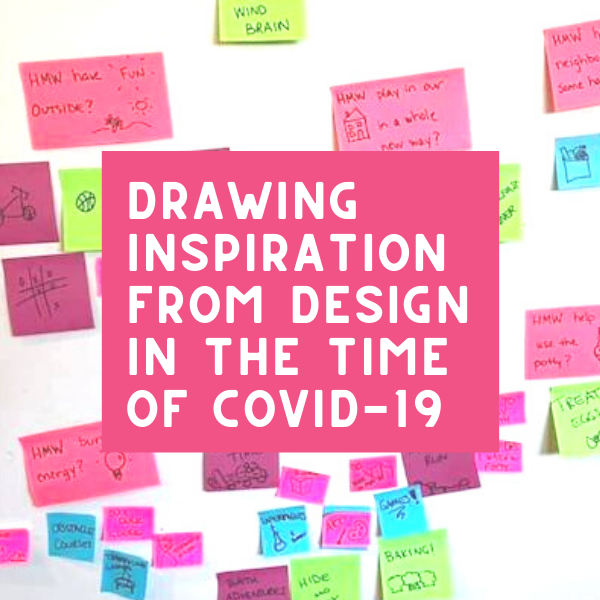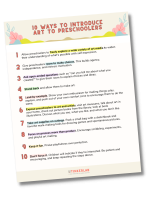Work grinds to a halt or transforms radically. Parents and family members become untrained homeschooling teachers. Our worlds have simultaneously narrowed to the walls of our homes (if we are lucky enough to have one) and widened to welcome many in through video conferencing.

As we collectively face a confusing combination of enormous constraints and immense ambiguity, I have found comfort in the mindsets and tools of design as a way to find opportunities in constraints, to find creative energy out of ambiguity.
As an educational designer, I realized there might be a way I could help families who are navigating a difficult new normal and are buried under an avalanche of recommended schedules, resources and activities.
I am excited to share a few methods from design that I hope will help families to surface and reframe challenges they are facing, generate creative solutions to those challenges and feel empowered to collectively design their way forward.

The first method is a process for identifying the needs of the people in your family. This will ultimately lead to a process of collaboratively generating solutions through an empathetic approach.
Ask yourselves: What are the problems we are having? Why are these problems challenging? What do you need that is different?
For example:
What are the problems we are having?
It is too noisy during quiet time. It is hard to settle down and that causes us to argue. We bother Mom and Dad and get in trouble.
Why are these problems challenging?
I don’t like fighting with you. We also keep bothering Mom when she is trying to work.
What do you need that is different?
I need a way to relax during quiet time. I need a way to get my energy out without leaving the house. I need a way to avoid fighting with my sister.
Then, turn those needs into “How Might We” questions. In design thinking, we use the phrase “How might we…” to reframe a problem into an opportunity.
How might we find a way to relax during quiet time?
How might we feel as tired as we do after playing soccer without leaving the house?
How might we create new ways to resolve conflict?
Then, follow the rules of brainstorming to co-create solutions. The goal is to generate many, many solutions to a single question.
You do that by following these simple rules:
Defer judgement — hold off on evaluating the idea as good or bad until later.
Go for volume — try to come up with as many ideas as possible.
Encourage wild ideas — don’t limit yourself! Think outside of the box!
Build on the ideas of others “Yes, and!” — Through working together you will generate more creative solutions.
When we move away from solving a problem with one solution to generating many solutions, then we realize there is more than one way to accomplish our goals and meet our needs. And, we will have a wealth of ideas to draw from when something that works one day, stops working the next.
For example:
How might we find a way to relax during quiet time?
Try out meditation
Listen to classical music
Listen to a book on tape
Take a nap
Draw quietly
Do a jigsaw puzzle
Take a shower
Build a miniature castle, fairy house or fort from things in our bedroom (or recyclables)
Stare out the window
Work on a crossword puzzle
Exchange back rubs
How might we feel as tired as we do after playing soccer without leaving the house?
Do a workout video on YouTube
Go for a run in place
Do jumping jacks
Do sit-ups
Try yoga
Have a dance party
Walk up and down the stairs
Lift furniture as weights
Rearrange your room
How might we create new ways to resolve conflict?
Write down our feelings and exchange notes
Have a mediator help
Compromise
Switch up who gets to decide
Take a break
Listen for two minutes without saying anything
Step into their shoes
Say “I love you”
Give in (sometimes)
Share
Once you have generated a lot of solutions, as a group you can pick one solution and “prototype” it or try it out for a bit. We encourage taking an experimental approach to help us learn about a solution before we commit for the long-term. After you try something out, reflect as a group on what worked well and what didn’t. We like to use the feedback protocol: “I like, I wish, I wonder.” Then, try tweaking the idea to improve it and try again.
When an idea stops working, loses its novelty or if it never really works in the first place, return to your list and choose another idea. Or, trying brainstorming again.
In order to help you get started, here are a few starter HMW questions…
HMW learn something new without using the internet?
HMW learn something new without leaving the house?
HMW help our neighbors during this difficult time?
HMW use this unique time to accomplish something hard?
HMW create an atmosphere of surprise and delight at home?
HMW make the house feel like Disneyland?
HMW create a game that can only be played on the moon?
HMW invent a new way of being in the world?
HMW inspire our friends to try something new in their own house?
HMW we challenge ourselves to play independently?
HMW we reach out to friends and loved ones without leaving the house?
HMW throw a virtual party?
HMW connect with the neighborhood while maintaining a safe distance?
HMW do our part to help those in need?
HMW create a new morning routine for tomorrow?
HMW we bring an element of surprise to the day?
HMW learn from what animals do to come up with ideas to fill our time?
HMW use this time to learn something we’ve always wanted to learn about but never had the chance?
HMW work together as a team like the crew of a submarine?
HMW create a plan for our day inspired by the way astronauts live and work on the International Space Station?
HMW share with others what we know and learn?
HMW experience our house in a brand new way?
HMW find a way to relax during quiet time?
HMW feel as tired as we do after playing soccer without leaving the house?
HMW create new ways to resolve conflict?
HMW make a plan in uncertain times?
HMW help each other feel less anxious?

Check out my friend and colleague from Stanford’s d.school, Alissa Murphy and her two sons Nolan (3 years old) and Pax (4 years old), trying out these methods. Nolan renamed the process a “windbrain”! Alissa said the windbrain took about 30 minutes.
Download How Might We Starter Questions
Click here to download the How Might We? PDF

Katie Krummeck
Katie is an educational designer and a national thought leader in leveraging the power of design to drive change in the K-12 system. She began her career as a secondary teacher and co-founder of a small, experimental independent school, where students collaborated across age groups to engage in project-based, interdisciplinary learning. She has since helped scale a national education non-profit start-up, helped develop the K12 Lab at the Hasso Plattner Institute for Design at Stanford University (“the d.school”), and founded the Maker Education Project at Southern Methodist University, an initiative dedicated to catalyzing transformational maker-based learning experiences for students in K-12 schools. She believes that training both young people and adults with tools to develop creative confidence is the key to large-scale transformation of the educational system.
Website: www.katiekrummeck.com
Twitter: @kkrummeck
TINKERLAB®
TinkerLab is a creative studio dedicated to sparking curiosity and a love for art through hands-on making. Our mission is to inspire creativity and experimentation in makers and artists of all ages, transforming everyday moments into creative adventures.
USEFUL LINKS
GET IN TOUCH
10 WAYS TO INTRODUCE ART TO PRESCHOOLERS
An inspiring 10-point poster for your fridge, planning binder, or to share with colleagues or friends.

TinkerLab acknowledges the ancestral land of the Muwekma Ohlone Tribe, and pays respect to elders both past and present. This land was and continues to be of great importance to the Ohlone people, and we have a responsibility to acknowledge, honor and make visible the our relationship to Native peoples. Donate to the Association of Ramaytush Ohlone.

